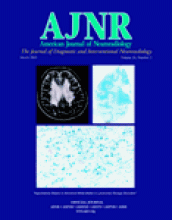Research ArticleNeurointervention
Patency of Perforating Arteries after Stent Placement? A Study Using an In Vivo Experimental Atherosclerosis-Induced Model
Osamu Masuo, Tomoaki Terada, Gary Walker, Mitsuharu Tsuura, Kunio Nakai and Toru Itakura
American Journal of Neuroradiology March 2005, 26 (3) 543-548;
Osamu Masuo
Tomoaki Terada
Gary Walker
Mitsuharu Tsuura
Kunio Nakai

References
- ↵WASID Study Group. Prognosis of patients with symptomatic vertebral or basilar artery stenosis: the warfarin-aspirin symptomatic intracranial disease (WASID) study group. Stroke 1998;29:1389–1392
- Chimowitz MI, Kokkinos J, Strong J, et al. The warfarin-aspirin symptomatic intracranial disease study. Neurology 1995;45:1488–1493
- ↵Thijs VN, Albers GW. Symptomatic intracranial atherosclerosis: outcome of patients who fail antithrombotic therapy. Neurology 2000;55:490–497
- ↵The EC/IC Bypass Study Group. Failure of extra-cranial/intracranial arterial bypass to reduce the risk of ischemic stroke: result of an international randomized trial. N Engl J Med 1985;313:1191–1200
- ↵Lanzino G, Fessler RD, Miletich RS, Guterman LR, Hopkins LN. Angioplasty and stenting of basilar artery stenosis: technical case report. Neurosurgery 1999;45:404–408
- Horowitz MB, Pride GL, Graybeal DF, Purdy PD. Percutaneous transluminal angioplasty and stenting of midbasilar stenoses: three technical case reports and literature review. Neurosurgery 1999;45:925–931
- Mori T, Kazita K, Mori K. Cerebral angioplasty and stenting for intracranial vertebral atherosclerotic stenosis. AJNR Am J Neuroradiol 1999;20:787–789
- Gomez CR, Misra VK, Liu MW, et al. Elective stenting of symptomatic basilar artery stenosis. Stroke 2000;31:95–99
- Gomez CR, Misra VK, Cambell MS, Soto RD. Elective stenting of symptomatic middle cerebral artery stenosis. AJNR Am J Neuroradiol 2000;21:971–973
- Levy EI, Horowitz MB, Koebbe CJ, et al. Transluminal stent-assisted angioplasty of the intracranial vertebrobasilar system for medically refractory, posterior circulation ischemia. Neurosurgery 2001;48:1215–1223
- Uchiyama N, Kida S, Watanabe T, Yamashita J, Matsui O. Improved cerebral perfusion and metabolism after stenting for basilar artery stenosis: technical case report. Neurosurgery 2001;48:1386–1392
- Lylyk P, Cohen JE, Ceratto R, Ferrario A, Miranda C. Endovascular reconstruction of intracranial arteries by stent placement and combined techniques. J Neurosurg 2002;97:1306–1313
- Levy EI, Hanel RA, Bendok BR, et al. Staged stent-assisted angioplasty for symptomatic intracranial vertebrobasilar stenosis. J Neurosurg 2002;97:1294–1301
- ↵
- ↵Masuo O, Terada T, Walker G, et al. Study of the patency of small arterial branches after stent placement with an experimental in vivo model. AJNR Am J Neuroradiol 2002;23:706–710
- ↵Geary RL, Williams JK, Golden D, Brown DG, Benjamin ME, Adams MR. Time course of cellular proliferation, intimal hyperplasia, and remodeling following angioplasty in monkeys with established atherosclerosis: a nonhuman primate model of restenosis. Arterioscler Thromb Vasc Biol 1996;16:34–43
- ↵Carter AJ, Farb A, Gould KE, Taylor AJ, Virmani R. The degree of neointimal formation after stent placement in atherosclerotic rabbit iliac arteries is dependent on the underlying plaque. Cardiovasc Pathol 1999;8:73–80
- Tominaga R, Harasaki H, Sutton C, Emoto H, Kambic H, Hollman J. Effects of stent design and serum cholesterol level on the restenosis rate in atherosclerotic rabbits. Am Heart J 1993;126:1049–1058
- ↵Welt FG, Woods TC, Edelman ER. Oral heparin prevents neointimal hyperplasia after arterial injury. Circulation 2001;104:3121–3124
- ↵Poerner TC, Kralev S, Voelker W, et al. Natural history of small and medium-sized side branches after coronary stent implantation. Am Heart J 2002;143:627–635
- ↵Levy EI, Boulos AS, Hanel RA, et al. In vivo model of intracranial stent implantation: a pilot study to examine the histological response of cerebral vessels after randomized implantation of heparin-coated and uncoated endoluminal stents in a blinded fashion. J Neurosurg 2003;98:544–553
- ↵Lopes DK, Ringer AJ, Boulos AS, et al. Fate of branch arteries after intracranial stenting. Neurosurgery 2003;52:1275–1279
- ↵Sousa JE, Costa MA, Sousa AG, et al. Two-year angiographic and intravascular ultrasound follow-up after implantation of sirolimus-eluting stents in human coronary arteries. Circulation 2003;107:381–383
- Park SJ, Shim WH, Ho DS, et al. A parlitaxel-eluting stent for prevention of coronary restenosis. N Engl J Med 2003;348:1537–1545
- ↵Schofer J, Schluter M, Gershlick AH, et al, E-SIRIUS Investivators. Sirolimus-eluting stents for treatment of patients with long atherosclerotic lesions in small coronary arteries: double-blind randomized controlled trial (E-SIRIUS). Lancet 2003;362:1093–1099
- ↵Tanabe K, Serruys PW, Degertekin M, et al. Fate of side branches after coronary arterial sirolimus-eluting stent implantation. Am J Cardiol 2002;90:937–941
In this issue
Advertisement
Osamu Masuo, Tomoaki Terada, Gary Walker, Mitsuharu Tsuura, Kunio Nakai, Toru Itakura
Patency of Perforating Arteries after Stent Placement? A Study Using an In Vivo Experimental Atherosclerosis-Induced Model
American Journal of Neuroradiology Mar 2005, 26 (3) 543-548;
0 Responses
Jump to section
Related Articles
- No related articles found.
Cited By...
This article has not yet been cited by articles in journals that are participating in Crossref Cited-by Linking.
More in this TOC Section
Similar Articles
Advertisement











